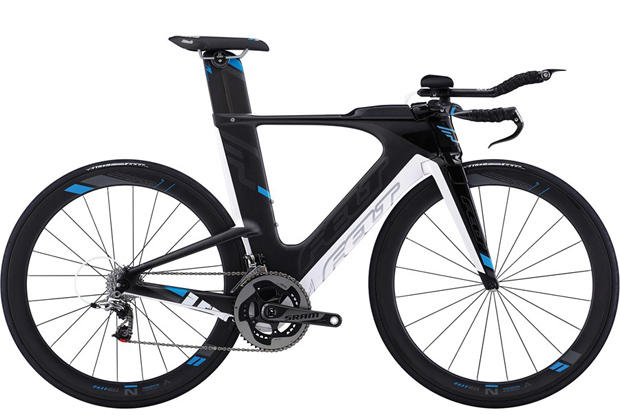Choosing Your Felt Superbike
This is not a review of the Felt IA. Reviews of the 2015 editions of this fine bike, and of Felt's DA, are upcoming. Rather, just like the installments last week on Trek's Speed Concept and Cervelo's P5 Six, we'll tell you below how to pick an IA or DA that fits you correctly.
And just like those earlier installments, a prerequisite is a knowledge of your proper fit coordinates. In other words, you tell me how you fit aboard your bike, and I'll tell you exactly which IA or DA you need to buy, with the precise stem and front-end you need (or if not the precise prescription, a very close approximation).

But in each case, with all these bikes, all these brands, garbage-in, garbage-out. If the position aboard your bike is poor, systems like the one I'll describe and demo below will accurately and quickly provide you with precisely the proper Felt IA that fits up underneath your crappy bike position. Changing your crappy position to a comfortable, powerful, aerodynamic position is not the purpose of what I'm writing in this installment, in the prior installments on Trek and Cervelo, and in upcoming installments on BMC and for other bikes.
So, for the purpose of this article, I'm assuming that your bike position is good, is dialed, and you only need to find the Felt IA or DA that precisely matches your position.
About calculators and systems like this: I think a lot of companies have been short-sighted in not thinking about the process by which their products get from their warehouses to customers' garages. The products are in many cases great. The processes by which those products pass from dealer to consumer is often not good, and for want of a nail the kingdom was lost (meaning, you can make a great bike and for want of a method for determining how to sell that great bike, that great bike doesn't get sold).
The process below is Felt's nail, allowing the kingdom to prosper. Felt made a great bike. Before today it had no system helping you determine which size and configuration of that bike was correct for you. Now Felt does have that system.
You'll need to download an Excel file that is the platform used for this system, which is accessible on Felt's site.
You know the drill by now, right? Type in your Pad X and Pad Y which is, in this spreadsheet, known as Pad Stack (Y) and Pad Reach (X). When I plunk these into the cells, along with my saddle height and saddle nose fore/aft, and I'm given a quite precise prescription. Using 630mm and 500mm for Pad Y and X, as I've used with the Trek and Cervelo, here's what the system outputs for me, and below is a close-up of a screenshot of the calculator:

The Output? Felt IA, 56cm with integrated stem, the Felt aerobar with 15mm of pedestal, and 30mm of forward push on the pads to get me the length I need.
I also am exhorted by the system to consider the 54cm with 35mm of pedestal and a 50mm forward push of the pads. Why would I not choose this? Remember in the P5 analysis, one option was the 54cm but the bike had a front/center of around 600mm, which was pretty short. A lot of weight on the front wheel. With the 56cm P5 I'm riding just over 620mm of front/center, which is also what I'd ride on a Speed Concept in size Large. The 54cm Felt IA has a front/center of 602mm, the 56cm a front/center of 630mm. That 630mm distance is perfect for me.
In way of explanation, my saddle nose is right over the BB. My Pad X is 500mm and my bar ends are about 80cm in front of the BB. All that places a lot of weight on the front wheel when I'm in the aero position. I need that extra little bit of front/center.
This Excel program is also a Felt DA calculator. The DA the calculator prescribes for me is size 58cm, with its 90mm long, 0mm rise stem, with 25mm of pedestal (+bridge), and the pads pulled back 10mm. This speaks to the longer, lower profile of this frame versus the IA. This is in fact exactly a bike I own and ride. This precise DA, with this stem. So the calculator is smack on.

In point of fact the DA rides a little long for me and what is long is the pursuit position. The final modification to this bike I made is a Zipp Vuka Bull flat pursuit bar, which is quite square to every axis rather than being swept forward, as is the (sometimes unfortunate) motif for base bars these days. This "pulls" the pursuit position back to a place more comfortable for me.
This calculator is going to give you "Best Options," "Great Options" and "Okay Options." All the options are theoretically achievable (at least in granting me my fit coordinates) and Felt may have a little work to do in filtering what goes in each box. My guess is that "Best" beats "Great" only in that Best gets closer, in millimeters, to my precise fit. But, wouldn't I be better with a 58cm DA with 4mm or 5mm too much pad height than a 51cm DA that is a couple of millimeters closer to my exact pad height?
But, look, it's much like with the P5 Six calculator. I could conceivably ride anything from a 51cm thru 56cm, and then it becomes an exercise in handling. Which of these bikes will handle the best? Which of these bikes will perch the pursuit bars in the right position versus the BB for me?
This MS Excel-based calculator, downloadable via clicking from a number of pages on Felt's website including this page, at least for me and my fit coordinates, passes the accuracy test.




Start the discussion at forum.slowtwitch.com